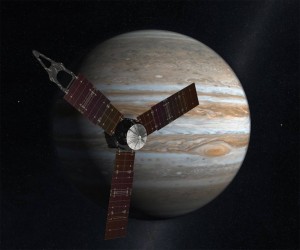Brave New Jupiter
 For the last five years, NASA’s Juno spacecraft has been barrelling towards its final destination: Jupiter, king of the planets. On 4 July this year, the four tonne, spinning craft – which looks like an oversized propeller that has abandoned its plane – will fire its thrusters and slow down enough to be captured by the gas giant’s gravity.
For the last five years, NASA’s Juno spacecraft has been barrelling towards its final destination: Jupiter, king of the planets. On 4 July this year, the four tonne, spinning craft – which looks like an oversized propeller that has abandoned its plane – will fire its thrusters and slow down enough to be captured by the gas giant’s gravity.
The burn should only last about 40 minutes, but they’ll be a tense 40 minutes: during that time, as Juno shifts from orbiting the Sun to orbiting Jupiter, the rest of its devices will go quiet. (As will the physicists at NASA’s Jet Propulsion Laboratory in Pasadena, California, tracking the mission from the ground and, one imagines, with fingers crossed.) Then the instruments should flicker back on, and over the course of more than 35 long, loping polar orbits throughout the following year, Juno will execute an intimate and unprecedented observation of our local colossus, beaming data back to Earth.
Scott Bolton, Juno’s principal investigator, says the effort to study Jupiter is no less than a desire to understand the origin story of the solar system. Bolton is a space physicist at the Southwest Research Institute in San Antonio, Texas, and has led the $1.1bn mission from idea to execution.
“When you want to understand where we all came from and how the planets were made, you have to start with Jupiter,” he says.
Read more in my story for the July issue of Physics World, here.